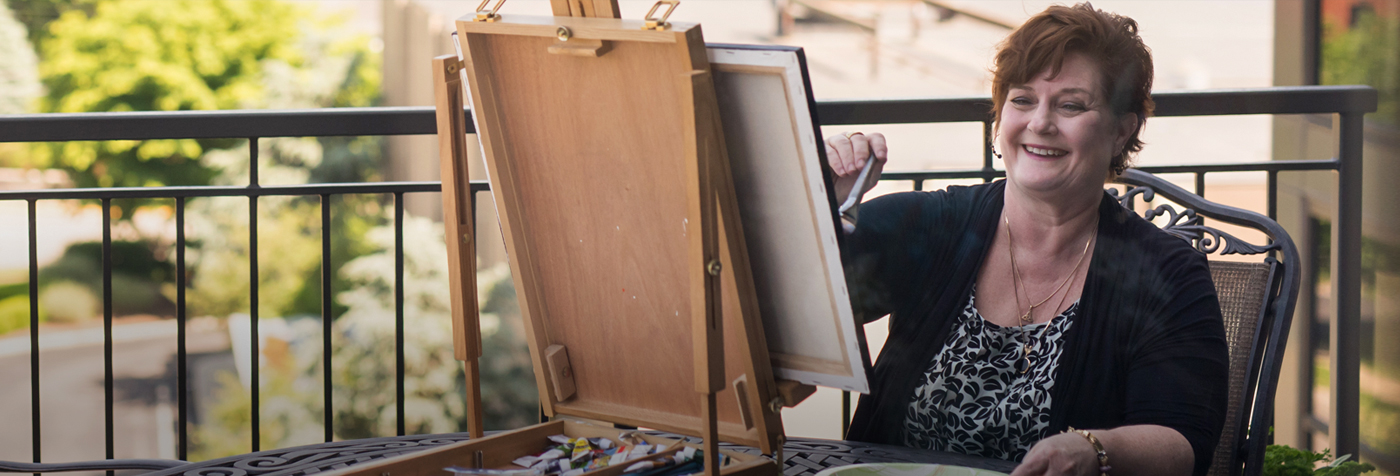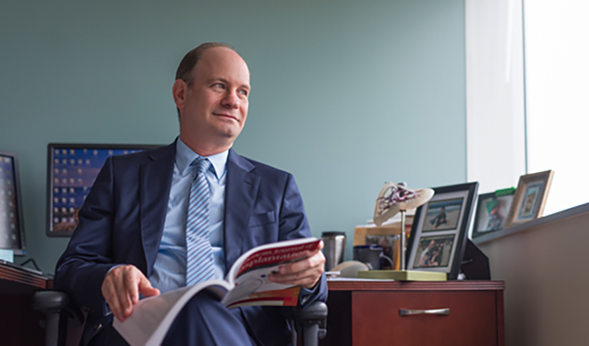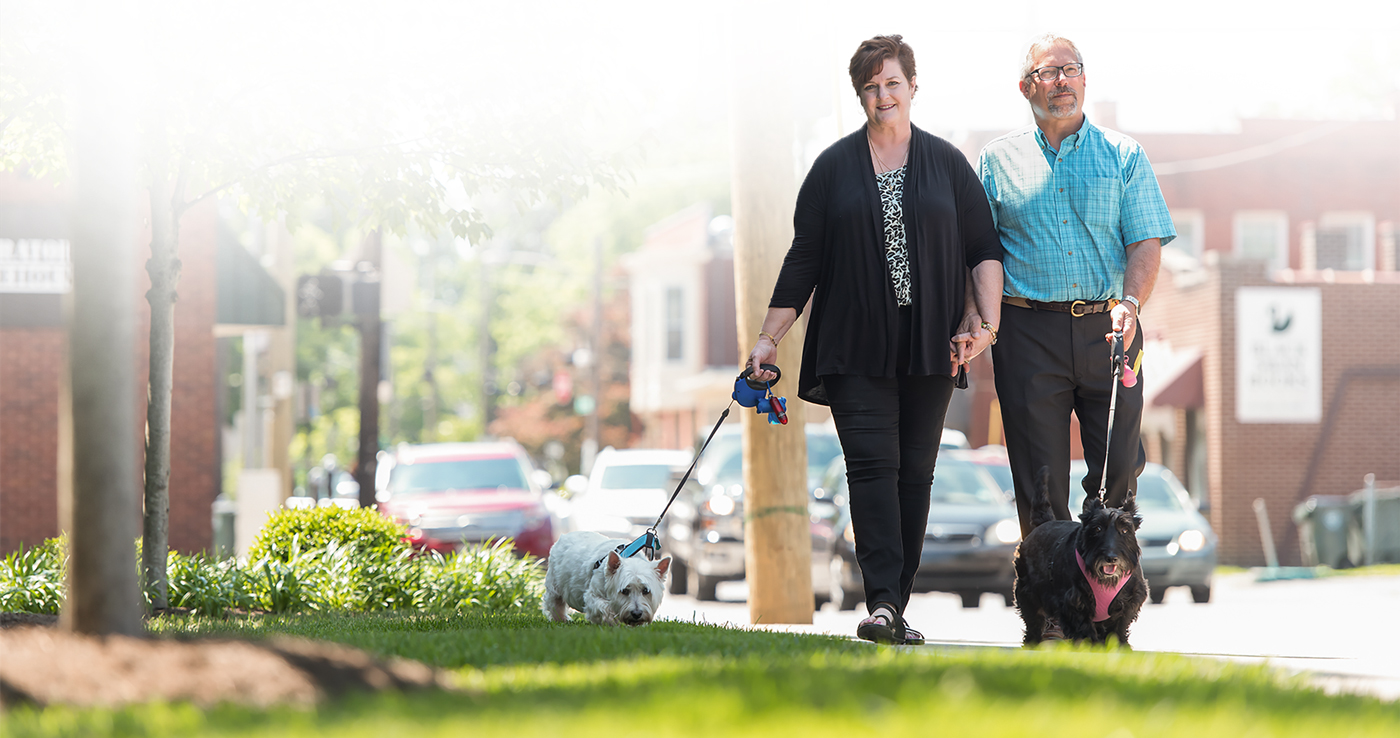Surviving end-stage organ failure, a liver transplant and cancer takes an extraordinary team

(2:18)
Teresa Schladt’s life-size self-portrait, painted in 2013 during an art therapy project for organ transplant patients at UK Chandler Hospital, shows the Lexington woman springing into a star-filled, midnight-blue sky. Inside each star is the name of someone who supported her through her 2007 liver transplant and cancer treatment and in the days since. There are many, many stars and many, many names, among them family, friends and more than a few UK HealthCare medical professionals.
As the 55-year-old looks at the painting and considers the life she has, she is quick to remind others and herself, “I am one of the luckiest people you have ever met. I am happy with life.”
Diagnosed with a genetic disorder at 35
Schladt was diagnosed at age 35 with alpha-1-antitrypsin (AAT) deficiency, a genetic disorder that can damage the liver and lungs. Her younger brother, David Bishop of Nicholasville, also has the disease and six years ago had a double-lung transplant at UK Chandler Hospital.
For a decade after her diagnosis, Schladt, a Lexington native, lived an active, near-normal life. “I was symptom-free for so long,” she said. She and her husband, Tom, raised three children in a farmhouse they restored off Harrodsburg Road. Teresa, a UK graduate and chemical engineer, started her own environmental engineering firm.
But in late 2006, her health took a turn. The private-practice gastroenterologist who had long monitored her AAT deficiency referred her to the UK Transplant Center. “I was pretty healthy, but it hit me hard and fast,” she said.
AAT is far down the list of reasons for transplantation, ranking probably sixth or seventh, said Roberto Gedaly, MD, who performed Teresa’s surgery and remains her doctor. The UK Transplant Center sees only a few cases of AAT deficiency a year, he said. According to the Alpha-1 Foundation, some 100,000 Americans have the disorder.
In January 2007, Schladt began the required tests and screenings for a transplant; based on the results, she was placed on the transplant list in March 2007.
As she waited for a new liver, transplant advanced practice provider Michael Cooper, PA-C, MPAS, monitored Schladt’s liver function during visits to the Transplant Center clinic. The Schladts and Cooper, an Air Force veteran, found common ground – the Schladts’ son Michael was joining the Air Force, and Cooper was happy to tell about the time he had spent in the military.
As months passed, there were warning signs that Schladt’s liver was failing rapidly, including esophageal varices, a life-threatening condition in which blood vessels in the esophagus bulge and then burst. “She had lots of trips to the UK emergency room to tie off the veins in her esophagus that were bleeding,” said Tom Schladt. “Her liver was turning into a rock, and the blood flowing through the liver had to find a way to get out.”
By July, there was visible evidence that Teresa Schladt was in endstage organ failure. “I was turning yellow,” she said.
The call that a liver was available came on June 9, 2007, as Schladt, her husband and their two daughters watched “Pirates of the Caribbean II” at a movie theater near their home. Within 30 minutes, they were at Chandler Hospital.

A cancer diagnosis on the heels of a transplant
Schladt’s transplant went well, but 10 days later, tests on the removed liver revealed 10 small cancerous lesions. “It was a shock to everyone,” said Gedaly. In those days, despite screenings, liver cancer would be discovered in an explanted liver 10 to 15 percent of the time at UK, according to Gedaly. “It is what we call incidental hepatocellular carcinoma (HCC).”
Today, according to Gedaly, it happens far less often because of changes in screening methods. “Now we use MRIs, and it is less and less common for liver transplant recipients to have liver cancer incidentally found.”
Because Schladt’s cancer was advanced, with multiple lesions, Gedaly referred her to Philip DeSimone, MD, a medical oncologist at the Markey Cancer Center. “There was so much disease, we wanted to do something, which is why I called Dr. DeSimone.”

Both Gedaly, whose research area is liver cancer, and DeSimone, whose practice areas include liver, pancreatic, gastrointestinal and colorectal cancers, knew that a drug used primarily for kidney cancer, Nexavar®, was being used off-label in some liver cancer cases after liver transplantation. There was little data to show it was effective in cases like hers, but both doctors felt it was worth a try.
DeSimone pulled no punches. Schladt had two choices: Nexavar or no treatment.
“She was nice and appreciative of what I was trying to do,” said DeSimone, “even though there was little, really no data, to show if it [the treatment] was either good or bad. But you need to be aggressive when you have spent so much time and so much effort in saving someone’s life.”
DeSimone also warned the Schladts that it was not a question of if her cancer would return, but when. “He was straightforward,” said Tom Schladt, “but that is really all we are looking for in a doctor – straight answers.”
Schladt opted to take Nexavar in pill form. The six-month chemotherapy regimen left her sick and weak, but she has no regrets and has remained cancer-free.
“Did it help save my life? I don’t know,” said Schladt. “But for me, during that time, I felt I needed to give the best effort and that included Nexavar.”
Since Schladt’s surgery, the connection between the two specialty areas – transplantation and cancer – has become even more structured at UK HealthCare with the creation of a Liver Tumor Board whose members from transplant, oncology, radiation oncology, radiology and gastroenterology discuss every patient with liver tumors.
“Cancer is like transplant in that multidisciplinary is the way to go, with a lot of people thinking from different perspectives,” said Gedaly.

Moving forward with a UK medical team
As a transplant recipient and cancer survivor, Schladt remains under the care of a team of medical professionals at UK HealthCare. She has consultation with the Markey Cancer Center’s Long-term Cancer Survivorship Program. Most of her care, though, is through the Transplant Center. She visits every other month for blood tests and for an annual checkup with Gedaly and his team.
Like other transplant patients, much of Schladt’s time at the Transplant Center has been spent in the waiting room. She applauds receptionist Joanne Dabit-Shadeh and the late Marva Paris, LPN, who were there to greet her through most of the years.
“They know patients’ families, their history, they greet everybody. It is personal, and they go out of their way to be that way,” said Schladt. “Joanne and Marva were always genuinely happy to see me. They wanted you to succeed.”
Dabit-Shadeh, now a senior patient services coordinator, considers herself a patient advocate.
She’ll track down doctors and nurses if patients have urgent needs or serious problems; she’ll try to squeeze in tests so patients with long drives do not have to make an extra trip back to the center. When patients have trouble walking or standing, she and her staff take paperwork out to them and sit and visit as the paperwork is filled out. “I do whatever it takes to get the patient what they need,” Dabit-Shadeh said.
“People don’t realize how important it is for the front-desk staff to interact with patients and families” she continued. “I am the first person they see and the last person they see. We make an impression.”

Until Jennifer Watkins, RN, CCTC, moved into quality assurance and performance improvement in 2013, she was Schladt’s transplant coordinator.
No matter the question or concern, Watkins or the coordinator on call, has always been there for the Schladts. Tom Schladt never left his wife’s side during her 10-day post-transplant hospitalization; he was actively involved in her care and recovery. “Jennifer was the one who helped my husband the most,” Schladt said.
If Schladt falls ill and must go to the emergency department, the first call she makes is to her transplant coordinator. “Anytime she enters the UK HealthCare system, we smooth the path for her,” Watkins said. “We let admitting know that she is one of our transplant patients.”
It is also the role of the transplant coordinator, as well as floor nurses, to educate transplant patients. “Transplant is a change in the way you live your life,” said Watkins. “It is not as if you come in and get a new liver and see us a couple of times and you are done. In some way, we are connected to you forever.”
Dietitian is part of the care team
Schladt is also connected to the Transplant Center through liver and kidney transplant dietitian Susan Ibanez, MS, MBA, RD, LD. Schladt’s transplant was done before Ibanez came on staff, but since Ibanez was hired eight years ago, she has seen Schladt in the center’s clinic.
“The main part of my job,” said Ibanez, “is to work with all patients, before and after transplant. I tell patients they have me as their dietitian from start to finish. This includes providing nutrition education and tips to help improve their overall nutrition and maintain their strength so they can better withstand transplant.”
In 2015, transplant requirements changed. It is now mandated that the dietitian see patients before they are placed on the transplant list. “This process was implemented in the UK Transplant Clinic in July, and it is a good change for patients,” said Ibanez. “Previously, I saw patients on a consult basis, and there were often people who fell through the cracks. Now, I see every patient, which helps continuity of care.
“Usually, I have seen patients five to six times before transplant and I follow them closely in the clinic after transplant. They often have problems in those early weeks with poor appetite, nausea and weight loss. Then sometimes, a year later, I see them because they have gained too much weight.”
The new process results in more comprehensive care, Ibanez believes. “Now, I can develop a rapport with patients and work with them on the post-transplant side as well.”
As a patient, Schladt has been informed and proactive, Ibanez said. “Teresa is passionate about taking care of the organ.”

Onset of type-2 diabetes raises concerns
Diet has become even more critical for Schladt since she developed type 2 diabetes, the result of anti-rejection medications and family history.
In 2010, the Transplant Center referred her to diabetologist Kristen Stakelin, MD. Working with Stakelin, Schladt got off insulin and now controls her diabetes with other medications, exercise and diet.
“I see Teresa every three to four months and she has one of the best attitudes of anybody I see,” said Stakelin. “She is very proactive in taking care of herself, and she researches things. She doesn’t wait for us, but she is very reasonable in what she researches and what she is willing to do.”
As a patient, Schladt appreciates the time Stakelin spends with her.
“That is actually one of the things as a physician that I am the biggest advocate of: for patients to be well informed and well educated about why we are using which therapies or why we think one therapy will work better than another,” Stakelin said. “I feel like when patients understand ‘why’ they are much more likely to follow through. It also gives them some input into the treatment. I think when people are offered choices and they feel empowered to have a say in their therapy, they are much more proactive to take care of themselves and be compliant.”
“When you get to take the time with patients – and yes, that makes me run behind in clinic – it makes a difference. It makes patients feel valued. I have had so many people say, ‘Thank you for listening; nobody is sitting and listening to me like that,’ which makes me sad that we have progressed to that as a medical community – where patients are not feeling heard and we are just trying to rush everyone through. If you have someone who will listen, even if I can’t change anything for them, just getting to talk is often therapeutic.”
A full, fulfilling life
Even as Schladt contends with continuing health problems caused by AAT deficiency, she is living a full life, with few limits.

Most days, she and a friend venture to Fayette Mall to walk. “The older people, they pass me,” she says, ruefully. On those walks and others of length, Schladt uses supplemental oxygen. AAT has started to impact her lungs, just as the disease has now started to impact her brother’s liver.
She takes her dogs, Madame Curie and Sir Isaac Newton (“Can’t you tell Tom and I are both engineers?” she asks.) for walks; she and Tom walk downtown to the movies, to dinner and to the High Street YMCA, where they take tai chi. She keeps up with her three adult children: Michael, an engineer; Nicole, in law school at Emory University; and Rebecca, an engineering major at UK.
Schladt is also active in the wider community. For the past two years, she’s been a member of the Markey Cancer Center Patient Advisory Group. She’s proud that the group got benches placed between the parking lot and the center’s buildings. “Now there are places to sit down as you go to your car if you have to,” she said. “I hope I am helping make the lives of cancer patients a little more comfortable.”
The 2013 Body Mapping art therapy project at UK reawakened a long-dormant interest in art, and she spends time painting in her downtown condo. Its architecture makes it a natural art studio, with a two-story wall of glass facing west, toward UK.
During the day, the sun beams in. At night, she sees stars, a shining reminder of the stellar support system that has seen her through the last nine years.







